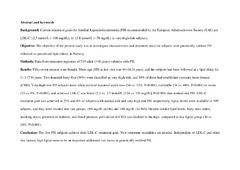LDL-cholesterol goal achievement, cardiovascular disease, and attributed risk of Lp(a)in a large cohort of predominantly genetically verified familial hypercholesterolemia
Permanent lenke
https://hdl.handle.net/10037/17653Dato
2019-01-30Type
Journal articleTidsskriftartikkel
Peer reviewed
Forfatter
Bogsrud, Martin Prøven; Græsdal, Asgeir; Johansen, Dan; Langslet, Gisle; Hovland, Anders; Arnesen, Kjell Erik; Mundal, Liv; Retterstøl, Kjetil; Wium, Cecilie; Holven, Kirsten BjørklundSammendrag
Objective - The objective of the present study was to investigate characteristics and treatment status in subjects with genetically verified FH followed at specialized lipid clinics in Norway.
Methods - Data from treatment registries of 714 adult (>18 years) subjects with FH.
Results - Fifty-seven percent were female. Mean age (SD) at last visit was 44 (16.3) years, and the subjects had been followed at a lipid clinic for 11.1 (7.9) years. Two hundred forty-five (34%) were classified as very-high-risk, and 44% of these had established coronary heart disease. Very-high-risk FH subjects more often received maximal statin dose (54% vs 33%, P < .001), ezetimibe (76% vs 48%, P < .001) or resins (23% vs 9%, P < .001), and achieved LDL-C was lower (3.2 vs 3.5 mmol/L [124 vs 135 mg/dL], P = .003) than normal-risk FH. LDL-C treatment goal was achieved in 25% and 8% of subjects with normal-risk and very-high-risk FH, respectively. Lp(a) levels were available in 599 subjects, and they were divided into 2 groups: ≥90 mg/dL (n = 96) and <90 mg/dL (n = 503). Despite similar lipid levels, body mass index, smoking status, presence of diabetes, and blood pressure, prevalence of coronary heart disease was doubled in the high- compared to low-Lp(a) group (30% vs 14%, P < .001).
Conclusion - Very few FH subjects achieve their LDL-C treatment goal. New treatment modalities are needed. Independent of LDL-C and other risk factors, high Lp(a) seem to be an important additional risk factor in genetically verified FH.


 English
English norsk
norsk